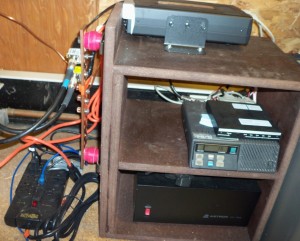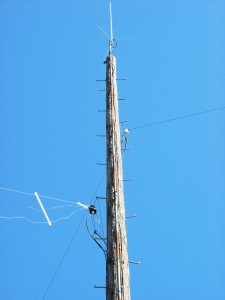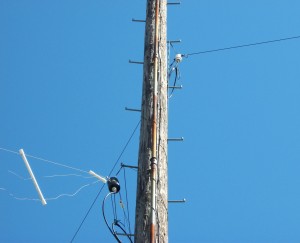Remote ham (HF + 6m) amateur radio station
Our remote station in Huron SD (NT5HS in EN04) was up and running from September 2010 to late 2013.
Details below…
Our remote station is a fairly simple remote HF/6m station, 900 miles from our Texas home. It does not have rotors or remote coax switches or an amplifier, nor will it be a serious contest station. It is a fun station, though! It has:
-
Dell GX620 mini-tower desktop with WinXP (a well-regarded desktop from not many years past, easily found on ebay)
-
Kenwood TS-480/SAT from Gigaparts (I considered a TS-B2000, but the budget disallowed it, and the 480 has a better receiver anyway) — my notes on the TS-480
-
Donner sound card interface (no longer made), put in for digital modes (PSK, RTTY, JT65-HF, etc), but also used for all audio from rig to computer
-
Astron RS-35A power supply from Gigaparts
-
GE MVS + Kantronics KPC-3 for APRS I-gate
-
2 multi-band HF wire antennas:
1- Buckmaster 7-band OCF (300w version) (reviews, 3kw version reviews)
2- homebrew multi-band (fan) dipole to cover 30m/15m/6m
(pictures are below)
We now have SSB and digital capabilities, on 6m and most HF bands (excluding 60m & 160m). I don’t plan to mess with CW much (which I do use on occasion at home), but it does work (using CWType & CWGet). Callsign used at this station will generally be NT5HS.
A simple diagram:
manned setup | <== broadband => | REMOTE (unmanned/host) setup
home or laptop PC | <== internet ==> | remote/host desktop PC;
running browser | | sound card hooked to
w/ mic & speakers;| | digital interface; TS-480 + antennas;
LogMeIn & Skype | | computer auto-starts LogMeIn & Skype
HOW is all this done? It isn’t super-complicated, but there is a bit to it.
The remote/host computer has all the normal software to run a TS-480, including Kenwood ARCP-480, Ham Radio Deluxe, Digipan, MMTTY, JT65-HF, logging software (eham reviews), and other similar software. Some guys use TRX-manager as one option. The remote/host PC has Skype with auto-answer turned on. This is to get audio to/from the PCs. And it has Dimension 4 (D4) software (free) to keep the time very accurate. (Meinberg is another good clock-setting option.)
My remote/host PC doesn’t even have a monitor hooked up, or a keyboard or a mouse. The TS-480 doesn’t have a control head attached (I sold it – don’t need it!). To be able to hook to the rig for rig control, and to also hook up to the Donner sound card interface, I installed a PCI card that adds two serial ports (under $15 on ebay), though a person could use an external USB-to-serial adapter. (I also use the third serial port to hook up to a Kantronics KPC-3, hooked up to an old commerical GE MVS 2m radio to run UI-View as an APRS I-gate. This ensures that any APRS signals repeated with my N0RQ-15 APRS digi get sent to the internet.)
To be able to control the remote/host PC, I use LogMeIn Free, which is installed on the remote PC, and controlled from the manned/control PC (home PC or a laptop). It is pretty easy to set up and use, and works very well. (And yes, the free version will do what you need.) The remote PC has good broadband internet available. (LogMeIn Pro2 does audio, but the free version does not — no problem, Skype will do the audio for us.) Alternatives to LogMeIn include:
-
TightVNC, but I have no experience with it
-
Radmin Viewer, though I know nothing about that one
-
GoToMyPC.com ($$$)
-
some guys will even use the built-in Windows XP (Professional, not Home) Remote Desktop
The free version of LogMeIn is quite impressive, though, so I’m going to stick with that.
The manned/control PC has LogMeIn and Skype and a browser — no other software needed. In reality, you can control your remote station from any internet-connected PC in the world (assuming you’re doing digital modes and don’t need sound/Skype), as the LogMeIn add-in app for the browser will install automatically when it is needed (in it won’t bother anyone else by being there).
In less than a week, I successfully had about 10 PSK31 QSOs, over a dozen SSB QSOs, and yes, even one contact on CW! In other words… it works! In December 2010, I messed around with the TARA PSK “DeathMatch” contest, and made about 40 PSK31 & PSK63 contacts. There were no glitches with the setup.
April 2011 update: finished WAS (worked all states) on digital (mode JT65-HF)! Also made quite a few PSK31 Qs, and worked Belguim on SSB.
Here are pictures of the setup — obviously nothing exciting or fancy, but it does the job:
on far left: Tripp Lite TPL810NET surge protector
on left of cabinet: Harger ground bar with 2 Alpha Delta surge protectors; #4 solid copper serves as ground wire to rig & outside
in cabinet: Astron RS-35A (on bottom), GE MVS 2m radio and Kantronics KPC-3 for APRS I-gate (middle), and on top is the body of the Kenwood TS-480/SAT
on far right, barely visible: part of the case of the Dell GX620 running WinXP Pro

Here are pictures of the antennas. At the top of the 50′ pole is a Diamond F22A 2m antenna for the APRS digipeater. The top wire antenna is the Buckmaster 7-band OCF (reviews, 3kw version reviews) for 10m, 12m, 17m, 20m, 40m, 80m (it won’t tune on 6m) at near 40′. The bottom wire is the homebrew fan dipole for 6m/15m/30m; the apex is at about 33′, with Centaur balun. The internal tuner in the TS-480SAT handles modest SWR issues with no problem.
The loop in the coax under each antenna is simply for support. The ropes (2 for each antenna) are attached to the balun AND to a reinforced section at the top of the coax loop — this keeps strain off the PL-259.
No, I didn’t climb up there to install the dipoles — I used a fishing pole with a weight and threw up the line (took a few tries, but not bad), and pulled up a string with it, then used the string to pull up the 2 ropes.
(The top 2m vertical for the APRS digi was installed several years previously by a local guy with a bucket truck.)

a closer look:

useful links on the subject of REMOTE STATIONS:
- notes on a remote TS-480 from KY6N
- K7AGE video showing his remote control of a TS-2000
- Interesting article in NCJ about How Not to Build a Remote SO2R Contest Station (part 1, part 2, sorry, links) with all sorts of details, by K6VVA
-
N6QPF’s 3-part (10 min. each) series on remote control HF with PSK31 emphasis (part 1, part 2, part 3)
- Remote Rig is another and totally different way to remote control a station
-
youtube video of a guy using a TS-480 and RemoteRig
-
youtube video of a guy in Taiwan operating his remote TS-480 in Sweden
- ARRL book on the subject (I haven’t read it)
- ARRL links on the subject
Detailed things to remember, things to think about, etc:
remote/host PC:
-
make sure it is a reliable machine!
-
make it as bare-bones as possible — don’t have a whole ton of useless software installed on it — consider reinstalling Windows, then put your needed ham software (rig control, digital modes, LogMeIn, Skype)
-
for Skype, you’ll obviously have a separate Skype name/account for the remote PC — not the same name as your control PC! set Skype for AUTO-ANSWER
-
think about removing the Windows login password
-
do whatever Windows updates you want in advance, then you may wish to consider turning that OFF when installing it remotely (I’m not a Windows basher, but hey, the occasional update could possibly cause you grief)
-
turn off any other useless software — I don’t even run an anti-virus, because it won’t be doing email or much web browsing
-
in the BIOS, set it so that it will wake up from LAN (called “remote wakeup” on my BIOS; some older BIOSes may not have that feature) — this will allow you to use LogMeIn on the control PC to TURN ON the remote PC (yes, really) — note, though, that if you don’t have static IP addr, and the IP addr changes while the computer is OFF, the LogMeIn start command will fail — so see the next item below to see how I handle that
-
in the BIOS, you should seriously consider (plan on!) having an automatic turn-on time — so that if the PC gets turned off for whatever reason, and the LogMeIn turn-on doesn’t work, it will power up by itself (once a day or once a week) — mine is set at once at day at 5am — you may also wish to set the BIOS power settings to TURN ON after a power failure
-
if it is an old hard drive (over 4 or 5 years), think about getting a new one
-
if you have an extra hard-drive, after everything is all set up, you may want to clone the hard drive to the backup hard drive (using free HDClone) — so that if the remote PC hard drive dies, all you have to do is swap the backup in (or have someone do it)
-
you may want to have an identical computer to swap in if the remote one has a problem — just remember the hard drive is the most important piece, because it contains all your software/installation/settings, and it is the most time-consuming to re-do
-
if it is an older machine, think about putting in a new clock battery (usually CR2032), in case the power is off — because if the clock gets reset back to 2006 or whatever, LogMeIn gets unhappy and won’t connect, then you’ll have a problem
-
on the clock, the built-in Win clock sync won’t fix the clock if it is off very far — in order to make sure the clock isn’t way off (causing LogMeIn to fail), install automatic clock sync software such as D4 (Dimension 4) (or Meinberg), and turn OFF the setting that says “max time correction 1 hour”, because you want it to fix the time even if the clock is 10 years off) — very accurate time is also a MUST for digital modes like FSK441, ISCAT, and JT65-HF
-
you may want to make sure you do have a mouse & keyboard plugged in, even if you don’t have a monitor — at least some PCs won’t boot without the keyboard (or it may be a BIOS setting)
-
do you want a UPS? (I don’t, but I do have a decent surge protector, Tripp Lite TPL810NET, covers ethernet & phone line, too)
-
some guys will install a webcam, pointed at their equipment, which could be used by Skype — interesting idea, but mine won’t have anything of significance to look at (no monitor, no rig control head, no meters on power supply, no rotors, etc — not much to look at)
-
think about security — thieves, water/moisture protection, etc; if you can get a webcam to upload a .jpg to the internet every X seconds (not just keep it on the local hard drive), that would be one possible way to catch anyone doing something they shouldn’t
-
you should think about how to transfer files to/from the remote PC — either with an email setup, or perhaps by uploading files to/from the web (consider using GoogleDrive, which seems to work great) — for instance, you may keep a log on the remote PC but want to transfer it to your main shack computer on occasion — so file xfer of some sort should be planned
-
don’t forget about checking router & firewall & dsl/cable “modem” settings at the remote site
-
spend a little time contemplating the question “What could go wrong?” — and then contemplate some answers 😉
-
after you get it working in your regular shack, let it run and use it (as a “remote”) for several weeks or several months before you actually take it to the remote location — it’s easier to fix & tweak when you can put your hands on it
remote radio/station:
-
very important: set the rig’s xmit timeout feature to 2 or 3 minutes, so that in case something goes wrong, the rig doesn’t stay stuck in xmit (TS-480 menu item #22)
-
you may want to set the rig to turn itself off after an hour or so of being unused (TS-480 menu item #59)
-
program the rig in advance: memories, settings, filters, antenna port settings, internal tuner settings
-
back up the rig settings, if applicable; keep the file on the remote PC and copy it to your control PC
-
make sure your power supply is reliable (which is why I picked a new Astron RS-35A instead of a smaller switching supply or even a used linear supply)
-
don’t forget grounding and lightning protection!
-
secure the cables (sound interface, serial rig control, power) so that you don’t end up with unwanted surprises (such as people tripping over wires, things falling, etc)
-
my TS-480/SAT won’t even have the control head on it, but if yours does, think about security — you don’t want unlicensed fingers fiddling with the rig; consider unplugging the mic and/or key and hiding it, if you have it there at all
-
don’t forget airflow — if you’re going to put a power supply, rig, and computer in a tiny corner, make sure the rig can get some air
-
antennas: if your remote station will be some distance from where you live, make sure to use quality rope to hang the wire antennas, and think about having 2 antennas in case one of them fails for some reason (at least you’d be able to use one or more bands)
Specific to the Kenwood TS-480 (and possibly the TS-2000): if you’re NOT using mic input, and all the audio is going through the sound card interface into the data port (easiest, and that’s what I do), then one “gotcha” in the ARCP-480 software: in Control/Setup, in the “TX Control” box, have DTS checked, NOT PTT — this tells it to route xmit audio through the data port, not the mic port. Thanks to KY6N for that tidbit! If you know HOW to get voice audio to go through the mic jack, please let me know — I tried and tried, and simply couldn’t get it to work. (It would be better for SSB.)
Set the data port audio in/out levels as needed (TS-480 menu items #46 & 47 – mine are set at 7 and 2 respectively). Also, in the same Setup window, I’ve found that 38400bps is a good setting (TS-480 menu item #56) — higher or lower will work, but that gives good response for me.
